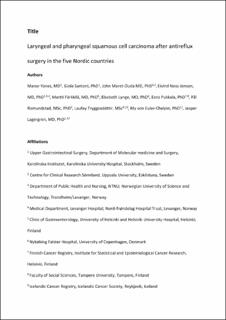| dc.description.abstract | Objective:
The aim of this study was to clarify whether antireflux surgery prevents laryngeal and pharyngeal squamous cell carcinoma.
Summary Background Data:
Gastroesophageal reflux disease (GERD) seems to increase the risk of laryngeal and pharyngeal squamous cell carcinoma.
Methods:
All-Nordic (Denmark, Finland, Iceland, Norway, and Sweden) population-based cohort study of adults with documented GERD in 1980 to 2014. First, cancer risk after antireflux surgery was compared to the expected risk in the corresponding background population by calculating standardized incidence ratios (SIRs) with 95% confidence intervals (CIs). Second, cancer risk among antireflux surgery patients was compared to nonoperated GERD patients using multivariable Cox regression, providing hazard ratios (HR) with 95% CIs, adjusted for sex, age, calendar period, and diagnoses related to tobacco smoking, obesity, and alcohol overconsumption.
Results:
Among 814,230 GERD patients, 47,016 (5.8%) underwent antireflux surgery. The overall SIRs and HRs of the combined outcome laryngeal or pharyngeal squamous cell carcinoma (n = 39) were decreased after antireflux surgery [SIR = 0.62 (95% CI 0.44–0.85) and HR = 0.55 (95% CI 0.38–0.80)]. The point estimates were further decreased >10 years after antireflux surgery [SIR = 0.48 (95% CI 0.26–0.80) and HR = 0.47 (95% CI 0.26–0.85)]. The risk estimates of laryngeal squamous cell carcinoma were particularly decreased >10 years after antireflux surgery [SIR = 0.28 (95% CI 0.08–0.72) and HR = 0.23 (95% CI 0.08–0.69)], whereas no such decrease over time after surgery was found for pharyngeal squamous cell carcinoma. Analyses of patients with severe GERD (reflux esophagitis or Barrett esophagus) showed similar results.
Conclusion:
Antireflux surgery may decrease the risk of laryngeal squamous cell carcinoma and possibly also of pharyngeal squamous cell carcinoma. | en_US |
